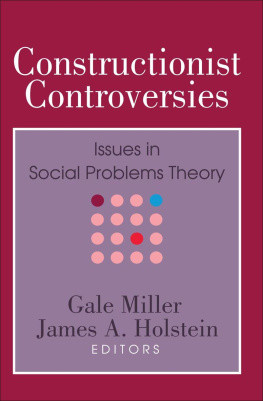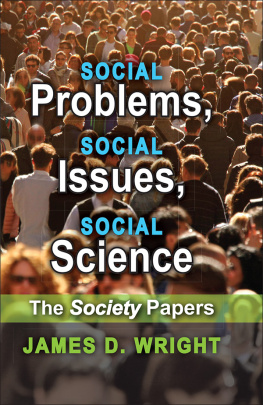Images of Issues
First published 1995 by Transaction Publishers
Published 2017 by Routledge
2 Park Square, Milton Park, Abingdon, Oxon OX14 4RN
711 Third Avenue, New York, NY 10017, USA
Routledge is an imprint of the Taylor & Francis Group, an informa business
Copyright 1995 by Taylor & Francis
All rights reserved. No part of this book may be reprinted or reproduced or utilised in any form or by any electronic, mechanical, or other means, now known or hereafter invented, including photocopying and recording, or in any information storage or retrieval system, without permission in writing from the publishers.
Notice:
Product or corporate names may be trademarks or registered trademarks, and are used only for identification and explanation without intent to infringe.
Library of Congress Catalog Number: 94-47575
Library of Congress Cataloging-in-Publication Data
Images of issues : typifying contemporary social problems / Joel Best, editor2nd ed.
p. cm.
Includes bibliographical references and index.
ISBN 0-202-30539-2 (pbk. : acid-free paper)
ISBN 0-202-30539-2 (pbk. : acid-free paper)
1. Social problems. 2. Sociology. I. Best, Joel.
HN28.I46 1995
361.1dc20
94-47575
CIP
ISBN 13: 978-0-202-30539-4 (pbk)
CONTENTS
John M. Johnson
Kathleen S. Lowney and Joel Best
Lynn M. Appleton
Shan Nelson-Rowe
Philip Jenkins
Shirley A. Scritchfield
Craig Reinarman and Harry G. Levine
Gwyneth I. Williams and Rhys H. Williams
Valerie Jenness
Karl R. Kunkel
Donileen R. Loseke
David F. Luckenbill
Lawrence T. Nichols
During the past 20 years, constructionism emerged as an influential orientation among sociologists who study social problems. The body of constructionist studies of social problems continues to grow, and awareness of the constructionist stance has spread to other disciplines, including history, political science, law, criminology, social work, and evaluation research. Yet relatively few social problems courses introduce students to this exciting perspective.
In part, this may be because the key constructionist works seem to address scholars, rather than students. The first edition of Images of Issues sought to fill this gap with a collection of papers, written in relatively accessible prose, that offered an introduction to the construction-ist perspective, dealt with timely issues, and contributed to the growing body of constructionist theory and research. But the substantive topics addressed in that 1989 edition quickly became dated as societal concerns shifted. Some issues, highly visible in the 1980s, dropped off the front pages in the 1990s, while new social problems attracted public attention.
This new edition reflects some of these shifts in concern. Only one of the substantive chaptersJohn M. Johnsons discussion of child abuse horror storiesis reprinted unchanged. Two other chaptersCraig Reinarman and Harry G. Le vine on crack and Shirley A. Scritchfield on infertility have been revised and updated. The remaining chapters represent recent work on new topics, including chapters on hate crimes, stalking, fathers rights, multiculturalism in education, and other issues that moved into the limelight since the first editions publication. Finally, the first editions afterwordwhich rather casually introduced the distinction between strict and contextual constructionismhas been extensively revised to discuss the theoretical debate among constructionists more systematically.
I want to acknowledge some of the people who helped me prepare this edition: the scholars and teachers who provided encouragement when they told me they found the first edition useful; the folks at Aidine de Gruyterparticularly Richard Koffler and Arlene Perazziniwho helped turn my second thoughts into a book; Donna Maurer, who handled some of the editorial chores; and Sue Treece, who managed the conversion of the various manuscripts into a single word-processing format.
PART 1
Introduction
Typification and Social Problems Construction
What do we mean when we speak of social problems? At first, the answer seems obvious: We mean such things as crime and discrimination and poverty. This books table of contents gives other examples of this sort. Each chapter in this book concerns a particular social problem: child abuse, stalking, alcoholism, and so on. We usually answer the question What are social problems? by pointing to such examples.
But we might try to develop a more abstract definition, one that fits all our examples. For instance, we might say that social problems are trouble spots within societysocial arrangements that do not work properly. Sociologists often define social problems along these lines. Thus, Bassis, Gelles, and Levines (1982:2) textbook Social Problems gives this definition; A social problem is a social condition that has been found to be harmful to individual and/or societal well-being. Another recent text states: A social problem, then, can be defined as a condition that: (1) is widely regarded as undesirable or as a source of difficulties; (2) is caused by the actions or inactions of people or of society; [and] (3) affects or is thought to affect a large number of people (Farley, 1987:2).
Objectivist Definitions And Their Limitations
These definitions suggest that the essence of social problems lies in objective social conditions and that some conditions are problems. Thus, someone armed with Bassis et al/s (1982) definition could evaluate various social conditions, deciding that Condition X is indeed harmful to either individuals or society, and therefore is a social problem, while Condition Ywhich fails to meet the criterion of harmis not a social problem. Such definitions are called objectivist because they define social problems in terms of objective conditions.
While they fit our common-sense notion of what social problems are, objectivist definitions have two key flaws. First, they minimize or even ignore the subjective nature of social problems. Not all harmful conditions are considered social problems. Consider nutrition. Medical authorities argue that the typical American diet contains undesirable levels of fats and cholesterol. This condition clearly fits Bassis et al,s definition of a social problem: This diet endangers the well-being of individuals, who face greater risks of heart disease and other medical disorders; and it also threatens societal well-being by forcing Americans to devote a growing share of their national income to health care. Yet the nutritional inadequacies of the American diet rarely appear on lists of social problems, even though the condition fits most objectivist definitions. This reveals the subjective nature of social problems: Social problems are what people view as social problems.
Histories of particular social problems reveal the importance of subjective judgments. For example, the contemporary feminist movement began to gain public attention around 1970. The movement aimed to get people thinking differently; it challenged traditional, taken-for-granted assumptions about womens place in society. By the early 1970s, some women were joining consciousness-raising groups, where they discussed issues in their lives. Women encouraged one another to make the personal politicalto understand that the difficulties individual women faced at home or at work were part of larger, societal problems, and that those problems needed to be addressed. Feminists began bringing these issues before the public; they held demonstrations, gave press conferences, wrote books and articles, and lobbied government officials. New terms began to appear in the press: sexism, wife abuse, sexual harassment, pay equity, and so on. Where pre-1970 textbooks on social problems rarely mentioned these issues, post-1970 texts routinely in-eluded one or more chapters on sexism and sex discrimination. Ob vi-ously, the objective conditions feminists attacked were not new; they had been around for a long time. The change was subjective. After 1970, people began including sexism, sex discrimination, and the like on their lists of social problems.






